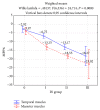Muscle fatigue in the temporal and masseter muscles in patients with temporomandibular dysfunction
- PMID: 25883949
- PMCID: PMC4391653
- DOI: 10.1155/2015/269734
Muscle fatigue in the temporal and masseter muscles in patients with temporomandibular dysfunction
Abstract
The aim of this study is to evaluate muscle fatigue in the temporal and masseter muscles in patients with temporomandibular dysfunction (TMD). Two hundred volunteers aged 19.3 to 27.8 years (mean 21.50, SD 0.97) participated in this study. Electromyographical (EMG) recordings were performed using a DAB-Bluetooth Instrument (Zebris Medical GmbH, Germany). Muscle fatigue was evaluated on the basis of a maximum effort test. The test was performed during a 10-second maximum isometric contraction (MVC) of the jaws. An analysis of changes in the mean power frequency of the two pairs of temporal and masseter muscles (MPF%) revealed significant differences in the groups of patients with varying degrees of temporomandibular disorders according to Di (P < 0.0000). The study showed an increase in the muscle fatigue of the temporal and masseter muscles correlated with the intensity of temporomandibular dysfunction symptoms in patients. The use of surface electromyography in assessing muscle fatigue is an excellent diagnostic tool for identifying patients with temporomandibular dysfunction.
Figures
Similar articles
-
The electrical activity of the temporal and masseter muscles in patients with TMD and unilateral posterior crossbite.Biomed Res Int. 2015;2015:259372. doi: 10.1155/2015/259372. Epub 2015 Mar 26. Biomed Res Int. 2015. PMID: 25883948 Free PMC article.
-
Activity and asymmetry index of masticatory muscles in women with and without dysfunction temporomandibular.Electromyogr Clin Neurophysiol. 2010 Nov-Dec;50(7-8):333-8. Electromyogr Clin Neurophysiol. 2010. PMID: 21284371
-
Effect of time of contraction and rest on the masseter and anterior temporal muscles activity in subjects with temporomandibular disorder.Codas. 2016 Apr;28(2):155-62. doi: 10.1590/2317-1782/201620150112. Codas. 2016. PMID: 27191879 English, Portuguese.
-
Review of clinical EMG studies related to muscle and occlusal factors in healthy and TMD subjects.J Oral Rehabil. 2007 Sep;34(9):631-44. doi: 10.1111/j.1365-2842.2007.01769.x. J Oral Rehabil. 2007. PMID: 17716262 Review.
-
Surface EMG of the masticatory muscles (Part 3): Impact of changes to the dynamic occlusion.Int J Comput Dent. 2013;16(2):119-23. Int J Comput Dent. 2013. PMID: 23930574 Review. English, German.
Cited by
-
Masticatory Myoelectric Side Modular Ratio Asymmetry during Maximal Biting in Women with and without Temporomandibular Disorders.Biosensors (Basel). 2022 Aug 18;12(8):654. doi: 10.3390/bios12080654. Biosensors (Basel). 2022. PMID: 36005050 Free PMC article.
-
The potential association between sedentary behaviors and risk of temporomandibular disorders: evidence from Mendelian randomization analysis.J Oral Facial Pain Headache. 2024 Dec;38(4):91-100. doi: 10.22514/jofph.2024.042. Epub 2024 Dec 12. J Oral Facial Pain Headache. 2024. PMID: 39800960 Free PMC article.
-
Diagnosis of Temporomandibular Disorders Using Thermovision Imaging.Pain Res Manag. 2020 Nov 17;2020:5481365. doi: 10.1155/2020/5481365. eCollection 2020. Pain Res Manag. 2020. PMID: 33282037 Free PMC article. Review.
-
Pressure Algometry Evaluation of Two Occlusal Splint Designs in Bruxism Management-Randomized, Controlled Clinical Trial.J Clin Med. 2021 May 27;10(11):2342. doi: 10.3390/jcm10112342. J Clin Med. 2021. PMID: 34071832 Free PMC article.
-
Differences between Maximum Tongue Force in Women Suffering from Chronic and Asymptomatic Temporomandibular Disorders-An Observational Study.Life (Basel). 2023 Jan 13;13(1):229. doi: 10.3390/life13010229. Life (Basel). 2023. PMID: 36676178 Free PMC article.
References
-
- Mohlin B., Axelsson S., Paulin G., et al. TMD in relation to malocclusion and orthodontic treatment. Angle Orthodontist. 2007;77(3):542–548. - PubMed
-
- Köhler A. A., Hugoson A., Magnusson T. Clinical signs indicative of temporomandibular disorders in adults: time trends and associated factors. Swedish Dental Journal. 2013;37(1):1–11. - PubMed
MeSH terms
LinkOut - more resources
Full Text Sources
Other Literature Sources
Medical
Miscellaneous


